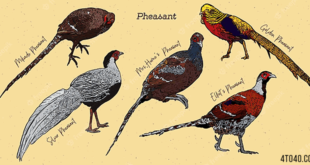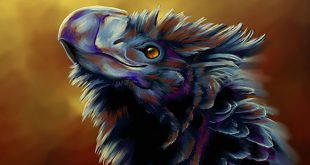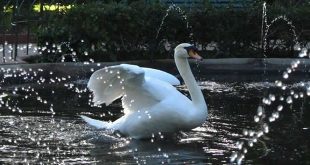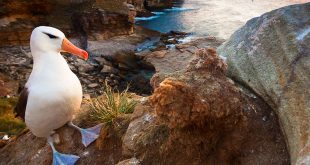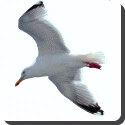 Gull — Gulls (often informally called seagulls) are birds in the family Laridae. They are most closely related to the terns (family Sternidae) and only distantly related to auks, skimmers, and more distantly to the waders. Until the twenty-first century most gulls were placed in the genus Larus, but this arrangement is now known to be polyphyletic, leading to the resurrection of several genera.
Gull — Gulls (often informally called seagulls) are birds in the family Laridae. They are most closely related to the terns (family Sternidae) and only distantly related to auks, skimmers, and more distantly to the waders. Until the twenty-first century most gulls were placed in the genus Larus, but this arrangement is now known to be polyphyletic, leading to the resurrection of several genera.
Gulls are typically medium to large birds, usually grey or white, often with black markings on the head or wings. They typically have harsh wailing or squawking calls, stout, longish bills, and webbed feet. Most gulls, particularly Larus species, are ground-nesting carnivores, which will take live food or scavenge opportunistically. Live food often includes crabs and small fish. Gulls have prophylactic unhinging jaws which allow them to consume large prey. Apart from the kittiwakes, gulls are typically coastal or inland species, rarely venturing far out to sea. The large species take up to four years to attain full adult plumage, but two years is typical for small gulls. Large White-Headed Gulls are typically long-lived birds, with a maximum age of 49 years recorded for the Herring Gull.
Gulls nest in large, densely packed noisy colonies. They lay two to three speckled eggs in nests composed of vegetation. The young are precocial, being born with dark mottled down, and mobile upon hatching.
Gulls the larger species in particular—are resourceful, inquisitive and intelligent birds, demonstrating complex methods of communication and a highly developed social structure. For example, many gull colonies display mobbing behaviour, attacking and harassing would be predators and other intruders. Certain species (e.g. the Herring Gull) have exhibited tool use behaviour, using pieces of bread as bait with which to catch goldfish, for example. Many species of gull have learned to coexist successfully with humans and have thrived in human habitats. Others rely on kleptoparasitism to get their food. Gulls have been observed preying on live whales, landing on the whale as it surfaces to peck out pieces of flesh.
Gull species range in size from the Little Gull, at 120 g (4.2 oz) and 29 cm (11.5 inches), to the Great Black-backed Gull, at 1.75 kg (3.8 lbs) and 76 cm (30 inches). They are generally uniform in shape, with heavy bodies, long wings, moderately long necks . The tails of all but three species are rounded; the exceptions being the Sabine’s Gull and Swallow-tailed Gulls, which have forked tails, and the Ross’s Gull, which has a wedge-shaped tail. Gulls have moderately long legs (certainly longer than the terns) with fully webbed feet. The bill is generally heavy and slightly hooked, with the larger species having stouter bills than the smaller species. The bill colour is often yellow with a red spot for the larger white-headed species and red, dark red or black in the smaller species.
The gulls are generalist feeders, indeed they are the least specialised of all the seabirds, and their morphology allows for equal adeptness in swimming, flying and walking. They are more adept walking on land than most other seabirds, and the smaller gulls tend to be more manoeuvrable while walking. The walking gait of gulls includes a slight side to side motion, something that can be exaggerated in breeding displays. In the air they are able to hover and they are also able to take off quickly with little space.
The general pattern of plumage in adult gulls is a white body with a darker mantle; the extent to which the mantle is darker varies from pale grey to black. A few species vary in this, the Ivory Gull is entirely white, and some like the Lava Gull and Heermann’s Gull have partly or entirely grey bodies. The wingtips of most species are black, which improves their resistance to wear and tear, usually with a diagnostic pattern of white makings. The head of gulls may be covered by a dark hood or be entirely white. The plumage of the head varies by breeding season; in non-breeding dark-hooded gulls the hood is lost, sometimes leaving a single spot behind the eye, and in white-headed gulls non-breeding heads may have streaking.
Gulls are highly adaptable feeders that opportunistically take a wide range of prey. The food taken by gulls includes fish and marine and freshwater invertebrates, both alive and already dead, terrestrial arthropods and invertebrates such as insects and earthworms, rodents, eggs, carrion, offal, reptiles, amphibians, plant items such as seeds and fruit, human refuse, and even other birds. No gull species is a single-prey specialist, and no gull species forages using only a single method. The type of food depends on circumstances, and terrestrial prey such as seeds, fruit and earthworms are more common during the breeding season while marine prey is more common in the non-breeding season when birds spend more time on large bodies of water.
Gulls are monogamous and colonial breeders that display mate fidelity that usually lasts for the life of the pair. Divorce of mated pairs does occur, but it apparently has a cost that persists for a number of years after the break up, and is thought to be selected against. Gulls also display high levels of site fidelity, returning to the same colony after breeding there once and even usually breeding in the same location within that colony. Colonies can vary from just a few pairs to over a hundred thousand pairs, and may be exclusive to that gull species or shared with other seabird species. A few species nest singly, and single pairs of Band-tailed Gulls may breed in colonies of other birds. Within colonies gull pairs are territorial, defending an area of varying size around the nesting site from others of their species. This area can be as large as a 5 m radius around the nest in the Herring Gull to just a tiny area of cliff ledge in the kittiwakes.
 Kids Portal For Parents India Kids Network
Kids Portal For Parents India Kids Network
